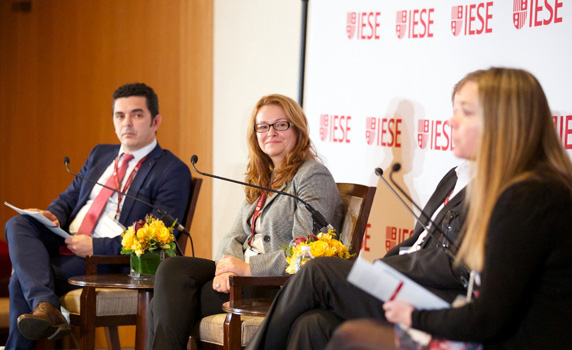
How can public service broadcasting deliver the highest quality content to audiences while meeting digital challenges and addressing growth?
This was the question raised by Kip Meyer, director of executive education at IESE, as he opened the "US-EU Media Dialogue on October 29. New York City Center’s Global Leadership Forum played host to the session, "Chasing Growth," which forms part of a joint IESE-UCLA custom program for the European Broadcasting Union.
The session convened two panels of Editors in Chief and Director Generals from some of Europe’s leading broadcasting organizations.
The Bigger the Budget, the Bigger the Market Share?
Professor Bill Baker, IESE’s distinguished professor of Media Management, kicked off the discussion by paying homage to the "awe-inspiring" market dominance of public service broadcasters in Germany, Switzerland and Finland. He contrasted the situation in Europe, achieved in no small part by the "robust contribution" from taxpayers, with the status quo in the U.S. The average American, he said, pays $1.25 toward public broadcasting’s operating budget of $400 million --- an anemic figure compared to the "dominant powerhouses of Europe."
Acknowledging this, Kai Gniffke, Editor in Chief of Germany’s largest public broadcaster, ARD, said that his Hamburg team alone has a budget of 40 million euros. ARD’s flagship 8pm newscast, Tagesschau, is watched by more than nine million people; significantly outperforming its top-ranking American equivalent.
The tie between substantial budget allocation and market share was underscored by Bernard Rappaz, editor in chief of news and current affairs at Switzerland’s SSR, which has an operating budget of 360 million euro. SSR has cornered 30% of the market share, and 60% of the share during primetime news -- something Baker describes as "unheard of in the US."
And the good news for European broadcasters doesn’t stop there. Finland’s Yle is also reaping the rewards of budget allocation and growing market share. Director of News, Current Affairs, Sport & Regional Programming, Atte Jääskeläinen, acknowledged that Yle is "going against the tide" with a market share of 42%.
But it’s not just a game of numbers. Audience loyalty is a key factor – to be earned, not bought, over time.
Trusted Sources of News
Growth doesn’t hinge on financial investment alone, said Gniffke. ARD’s success is built on "audience trust and a sense of "tradition. It has to do with our philosophy…the news is the star."
For Thomas Hinrichs, director of information at Germany’s Bavarian Radio, audience loyalty is directly related to "shared priorities. If people care about their country and democracy, they care about the issues."
The digital revolution poses specific challenges to broadcasters in terms of loyalty and retention. "In a digitalized world, people can choose from an enormous range of sources and platforms, and they still choose us," says Jääskeläinen. SSR’s consistently high market share is directly tied to Switzerland’s active democracy, generating a need for quality journalism to inform public discussion, said Rappaz.
Capturing the 18-35 Demographic
Rappaz also stresses the importance of embracing digital change to attract the younger demographic. But this is offset, he says, by the challenge of convincing internal teams that the "tsunami is coming."
Hinrichs also sees the opportunities and challenges of digital. "Younger people still are eager for relevant information, but want it whenever and wherever they want."
Because ARD currently brings in only 10% of those younger than 30, Gniffke says the reaction must be to use different platforms to bring their "trusted brand" to this demographic. Jääskeläinen agrees, citing Yle’s initiative to blend the "national agenda with a highly personalized approach" that individual needs into consideration.
Embracing the Competition
Rappaz subscribes to a "platform and media-agnostic" approach to distribution in response to intense and increasing competition. For Gniffke, the financial power of behemoths like Facebook and Google implies cooperation, rather than resistance, in developing distribution partnerships.
"Professional journalism" still carries competitive advantage however, says Hinrichs. "Google has no clue what’s going on the Bavarian forest."
Smaller Markets – Smaller Budgets: Bigger Challenges?
IESE Professor Sandra Sieber led the second panel, which took the focus to public service broadcasters in smaller countries, where budgets can vary radically.
Peter Dvorak, director general of Czech Television, talked about their market share of 30%, achieved on an operating budget of 200 million euro. Meanwhile in Bulgaria, state-owned BNT struggles to remain relevant on a budget of 32 million. She is proud of the state-owned organization’s "hard-earned success" in proving its independence to viewers after the fall of communism.
Mentor Shalar, director general of Radio TV Kosovo (RTK), operates on a 10 million euro budget. Kosovo has only two million citizens, and the mostly state-funded RTK receives no financial benefit from its popularity with Kosovans outside of the country.
The Advantages of Being Local
Dvorak believes that "local content makes the difference" in a small market because audiences demand content that is "directly relevant to their lives." The emotional impact of creating relatable programs and series is a powerful factor in building loyalty and retention.
BNT distinguishes itself from the competition, says Ankova, by focusing on locally relevant content, including political programs geared toward young people. This type of content can create strong emotional connection with audiences. Shalar remembers the intense audience outcry when RTK was forced to suspend two of the series it produces due to budget constraints.
The event closed with panelists expressing universal thanks to the EBU for its support. As Dvorak puts it: "The EBU’s fight for the importance of public media in helping us to convey our importance to the state and democracy."